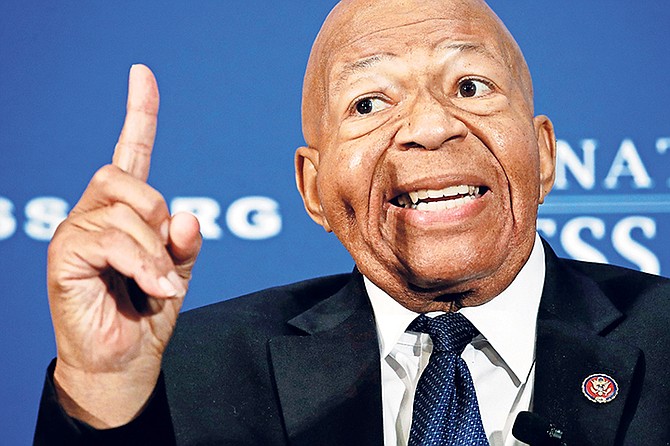Elijah Cummings has been harshly responding to the President’s often racist-sounding comments for several weeks.
With CHARLIE HARPER
Baltimore, the largest city in Maryland and the epicentre of its political life, has seen better days. Now 290 years old, the city was still America’s second largest - after only New York - as recently as 1850.
Baltimore would become home to hall of fame authors Edgar Allen Poe, Frederick Douglass, WEB DuBois, F Scott Fitzgerald, Dashiell Hammett, H L Mencken and Tom Clancy. Music legends Billie Holiday, Frank Zappa and Tupac Shakur called it home. And baseball home run king Babe Ruth, Supreme Court trailblazer Thurgood Marshall, House Speaker Nancy Pelosi and famed surgeon (and current Housing Secretary) Ben Carson also started out in Baltimore.
One-third of the city’s buildings have been granted a historic designation – the most for any US city.
But there has also long been a dispiriting side to this famous city. The mayor signed the first formal American urban segregation order there in 1910. Since 1950, each 10-year census has revealed a diminished population. The white population dwindled from 81 percent in 1940 to 30 percent in 2010. The black population in the city rose during the same period from 19 percent to 64 percent. Poverty levels increased and manufacturing jobs faded.
Four years ago, Baltimore’s homicide rate was 19 times as great as New York’s. And 93 percent of the victims of those homicides were black. In recent years, Baltimore has threatened or replaced Detroit or St Louis as America’s murder capital.
It gets worse. In 2017, Baltimore’s homicide rate was 56 per 100,000 population. This was a higher murder rate than in El Salvador, Guatemala or Honduras, three nations often cited for their high homicide rates amid ongoing civil war situations, rampant gang violence and corrupt, unrepresentative and repressive governments.
So when US President Donald Trump last weekend went on the offensive against Baltimore congressman and chair of the House Oversight and Reform committee, Elijah Cummings, it struck a nerve. Cummings is an imposing black figure whose West Baltimore district includes many desperately dilapidated neighbourhoods and yet also features slightly higher than average overall annual income levels among his constituents. Cummings has been harshly responding to the President’s often racist-sounding comments for several weeks.
Trump fired back by in turn by calling Cummings a racist who should be spending his time fixing the myriad poverty-related issues in his “putrid, rat-infested home district”.
Meanwhile, as Congress departed for a lengthy summer recess and horrific mass shootings in Dayton and El Paso shocked the nation, Democrats and pundits of both parties began to bring fully out into the open the term “white nationalists”.
Trump’s inability to avoid being tarred with a white nationalist brush, like so many of his difficulties, was largely self-inflicted. It dates to his sympathetic comments in the wake of a woman’s death during a neo-Nazi rally in Charlottesville in August 2017. Now the spectre of white nationalism is a primary attack weapon for his opponents, even as the president unapologetically panders to right-wing, largely white supporters.
The widely-respected, venerable Baltimore Sun newspaper has been a main news source throughout much of the city’s history and is known for its judicious opinions. But Trump’s attack on Cummings, and by extension his city, prompted the following editorial outburst:
“We would tell the most dishonest man to ever occupy the Oval Office, the mocker of war heroes, the gleeful grabber of women’s private parts, the serial bankrupter of businesses, the useful idiot of Vladimir Putin and the guy who insisted there are ‘good people’ among murderous neo-Nazis, that he’s still not fooling most Americans into believing he’s even slightly competent in his current post. Or that he possesses a scintilla of integrity. Better to have some vermin living in your neighbourhood than to be one.”
The Sun was clearly outraged. In a region and nation now so inured to insensitive, outlandish statements by its elected leader, it’s hard to know if the newspaper’s strong editorial will actually have any effect. One thing is for certain, though: Baltimore’s misery will continue.
Baseball trades in sporting doldrums
We are in the midst of summer doldrums in the major American sports. NFL training camps are now all in full swing and team rosters are bursting with nearly 100 players each. Almost half of them will not ever play a down in a real pro football game, dismissed from the roster by the time the first real games are played a month from now.
College football games are also weeks away. And though there are always a few truly interesting early matches to whet the appetite, most of the traditional powers play a fairly easy bunch of early games to warm up for their challenging league schedules.
All the headlines have already been written about the NBA and its increasingly powerful megastars and agents. They’re all on exotic holidays, promoting films or shoes, or simply counting their riches.
Hockey is in its annual summer hibernation, the NHL’s annual draft having passed without much impact except in certain hockey-crazed locales such as Buffalo and the major Canadian cities.
What sports fans have for now is baseball. This season, MLB cancelled its traditional August 31 trading deadline, requiring teams to essentially decide by the end of July if their playoff chances were sufficiently enticing to trade for extra hitting, pitching or defence. There would be no more acquiring players for the last third of baseball’s 162-game season.
This rule change has produced some interesting, almost counterintuitive results.
Take baseball’s three richest teams. None of the Dodgers, Yankees or Red Sox made a significant move, although they were at the centre of much of the pre-deadline buzz. The Dodgers and Yankees are running away with their respective divisions, so their inactivity made some sense. The Red Sox, so successful this century after their famous futility for almost the entire last one, haven’t shown the punch or spark that led them to last season’s World Series championship. Maybe Boston has simply run up the white flag for this year, but the team is still loaded with talent.
The Mets were also surprising, for a completely different reason. Totally written off a month ago amid team and management strife, the New Yorkers traded for a good starting pitcher, Marcus Stroman from Toronto, and gave away no one who will matter this season. Experts and observers were puzzled. But the Mets are on a terrific run now, having won 12 of their last 13 games, and are starting to talk about chasing down the Phillies and/or Nationals for a playoff berth.
The Houston Astros pushed all their chips to the middle of the table, trading several top prospects to Arizona for Zach Greinke, a very well-paid starting pitcher who gives Houston the best starting trio of pitchers in the game. Together with Justin Verlander and Gerrit Cole, both of whom also arrived via trades, the Astros match up favourably on the mound with any playoff opponent they will face.
American League pretenders Tampa Bay, Oakland and Minnesota made moves, but they aren’t getting to the World Series. Neither will the Cleveland Indians, though they dared to be great by swapping durable, talented but eccentric pitcher Trevor Bauer to Cincinnati for hitting punch and pitching depth from the Reds and San Diego.
The Atlanta Braves got strong relief pitching help from Detroit in Shane Greene and probably strengthened themselves the most of any team in the National League.
There’s still a lot of baseball left, but football is looming ever larger on the sports horizon. In September, action on the gridiron will return to the centre of almost every sports conversation. The doldrums will be long gone.






Comments
Use the comment form below to begin a discussion about this content.
Sign in to comment
Or login with:
OpenID